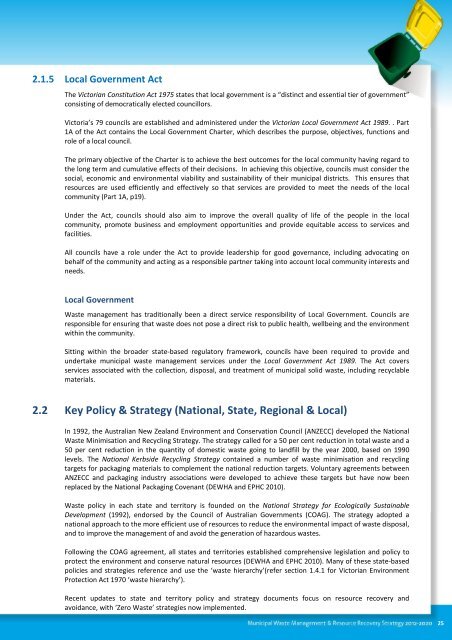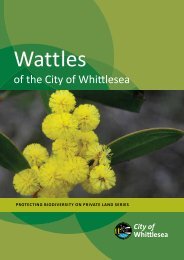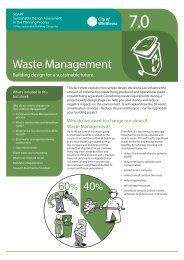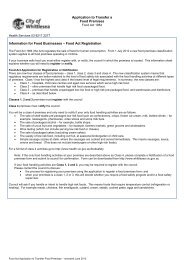Waste Management Strategy - full version - City of Whittlesea
Waste Management Strategy - full version - City of Whittlesea
Waste Management Strategy - full version - City of Whittlesea
You also want an ePaper? Increase the reach of your titles
YUMPU automatically turns print PDFs into web optimized ePapers that Google loves.
2.1.5 Local Government ActThe Victorian Constitution Act 1975 states that local government is a “distinct and essential tier <strong>of</strong> government”consisting <strong>of</strong> democratically elected councillors.Victoria’s 79 councils are established and administered under the Victorian Local Government Act 1989. . Part1A <strong>of</strong> the Act contains the Local Government Charter, which describes the purpose, objectives, functions androle <strong>of</strong> a local council.The primary objective <strong>of</strong> the Charter is to achieve the best outcomes for the local community having regard tothe long term and cumulative effects <strong>of</strong> their decisions. In achieving this objective, councils must consider thesocial, economic and environmental viability and sustainability <strong>of</strong> their municipal districts. This ensures thatresources are used efficiently and effectively so that services are provided to meet the needs <strong>of</strong> the localcommunity (Part 1A, p19).Under the Act, councils should also aim to improve the overall quality <strong>of</strong> life <strong>of</strong> the people in the localcommunity, promote business and employment opportunities and provide equitable access to services andfacilities.All councils have a role under the Act to provide leadership for good governance, including advocating onbehalf <strong>of</strong> the community and acting as a responsible partner taking into account local community interests andneeds.Local Government<strong>Waste</strong> management has traditionally been a direct service responsibility <strong>of</strong> Local Government. Councils areresponsible for ensuring that waste does not pose a direct risk to public health, wellbeing and the environmentwithin the community.Sitting within the broader state-based regulatory framework, councils have been required to provide andundertake municipal waste management services under the Local Government Act 1989. The Act coversservices associated with the collection, disposal, and treatment <strong>of</strong> municipal solid waste, including recyclablematerials.2.2 Key Policy & <strong>Strategy</strong> (National, State, Regional & Local)In 1992, the Australian New Zealand Environment and Conservation Council (ANZECC) developed the National<strong>Waste</strong> Minimisation and Recycling <strong>Strategy</strong>. The strategy called for a 50 per cent reduction in total waste and a50 per cent reduction in the quantity <strong>of</strong> domestic waste going to landfill by the year 2000, based on 1990levels. The National Kerbside Recycling <strong>Strategy</strong> contained a number <strong>of</strong> waste minimisation and recyclingtargets for packaging materials to complement the national reduction targets. Voluntary agreements betweenANZECC and packaging industry associations were developed to achieve these targets but have now beenreplaced by the National Packaging Covenant (DEWHA and EPHC 2010).<strong>Waste</strong> policy in each state and territory is founded on the National <strong>Strategy</strong> for Ecologically SustainableDevelopment (1992), endorsed by the Council <strong>of</strong> Australian Governments (COAG). The strategy adopted anational approach to the more efficient use <strong>of</strong> resources to reduce the environmental impact <strong>of</strong> waste disposal,and to improve the management <strong>of</strong> and avoid the generation <strong>of</strong> hazardous wastes.Following the COAG agreement, all states and territories established comprehensive legislation and policy toprotect the environment and conserve natural resources (DEWHA and EPHC 2010). Many <strong>of</strong> these state-basedpolicies and strategies reference and use the ‘waste hierarchy’(refer section 1.4.1 for Victorian EnvironmentProtection Act 1970 ‘waste hierarchy’).Recent updates to state and territory policy and strategy documents focus on resource recovery andavoidance, with ‘Zero <strong>Waste</strong>’ strategies now implemented.25
















